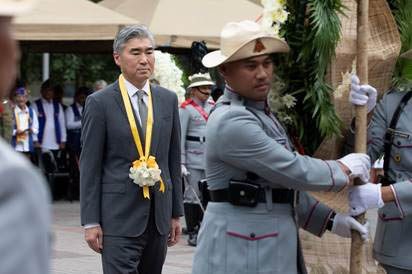SUMMARY
This is AI generated summarization, which may have errors. For context, always refer to the full article.

MANILA, Philippines – Without explicitly mentioning the Visiting Forces Agreement (VFA), US Ambassador Sung Kim highlighted the benefits of US troops’ presence and cooperation in the Philippines sanctioned by the agreement, which is now under question after President Rodrigo Duterte ordered its termination in late January.
On Monday, February 3, Kim spoke and laid a wreath to mark the 75th anniversary of the liberation of the University of Santo Tomas (UST) in Manila from having been an internment camp for civilians – mostly American – during World War 2.
Emphasizing how cooperation between US forces and Filipino guerrillas led to the liberation of some 4,000 detainees at the UST in the final days of the war in 1945, Kim said that “the bonds formed during those difficult years helped to forge the deep and enduring partnership that has defined the US-Philippines relationship to this day.”
“The alliance remains as important today as it was 75 years ago,” Kim added, noting how the Filipino and American militaries “work together to respond to humanitarian disasters, counterterrorism, and keep the Indo-Pacific region free and open for all nations.”
Kim then enumerated instances during which, he said, the military alliance proved crucial: the onslaught of Supertyphoon Yolanda (Haiyan) in 2013, and the terrorist siege of Marawi City in 2017.
The US deployed 13,400 troops, 66 aircraft, and 12 ships to assist in relief efforts in the aftermath of Supertyphoon Yolanda, which killed at least 6,000 people in the Visayas region. US forces helped evacuate more than 21,000 Filipinos and brought in aid and personnel to disaster-hit areas, Kim said.
“Our enduring military alliance enabled us to provide valuable advice, assistance, and equipment in support of the Armed Forces of the Philippines’ (AFP) efforts to liberate Marawi from terrorist control,” Kim added.
The US military’s presence in both instances were allowed for by the VFA, but Kim did not mention it in his speech at the UST. He has, so far, made no comment on Duterte’s order to terminate the pact.
Rotational presence
The Philippines gained independence from the US in 1946, after which they signed a Mutual Defense Treaty (MDT) in 1951. The US then had military bases in the Philippines until 1991, when the Philippine government voted not to renew the lease on the bases, forcing US forces to exit the country.
The VFA was signed and ratified in 1998, effectively allowing US forces to regain a rotational presence in the Philippines. It paved the way for joint exercises and other engagements between the two militaries.
An Enhanced Defense Cooperation Agreement (EDCA) was signed in 2014 to allow US troops to preposition assets in certain Philippine military bases, and in the process assist in the modernization of the AFP.
Showing aversion to the US ever since he took power in 2016, Duterte ordered to terminate the VFA on January 23, after Senator Ronald “Bato” dela Rosa said that his US visa had been cancelled.
The US Senate earlier passed a resolution to apply the Global Magnitsky Act to Philippine officials who had a role in extrajudicial killings in Duterte’s “war on drugs,” including denying them entry to the US. In its 2020 national budget, the US government included a provision calling for sanctions against Philippine officials behind the unlawful detention of Duterte critic Senator Leila de Lima, as well as extrajudicial killings.
Dela Rosa, as the first police chief under Duterte, operated the “war on drugs,” which the government said has killed more than 6,000 people since it began in mid-2016. Human rights groups estimate the number to exceed 20,000.
‘Enduring alliance’
It is unclear whether the Philippine government has officially notified the US government of an intention to end the VFA, but Duterte reiterated his order last week after his Cabinet said it would first study the implications and consequences of such a move.
Several members of Congress and even leftist groups, which usually oppose any US dealings with the Philippines, have criticized and opposed Duterte’s order to scrap the VFA, especially over Dela Rosa’s visa troubles.
Duterte and his spokesperson Salvador Panelo claimed it was a premeditated and calculated decision.
Defense Secretary Delfin Lorenzana said it was within the Philippine government’s rights to unilaterally call off the VFA if it no longer served the national interest.
The Philippine and US militaries hold 200 to 300 engagements every year, including a series of joint exercises in different parts of the Philippines.
There were some 300 such activities planned for 2020.
After Word War 2, the Philippines largely outsourced its external defense to the US. A drive to modernize the AFP to build a credible defense posture surged in recent years as China began occupying, reclaiming, and militarizing parts of the West Philippine Sea.
Security analysts have said that a robust military alliance with the US is a crucial deterrent to Chinese advances in the strategic waters.
At the ceremony at the UST, Department of National Defense Undersecretary for Defense Policy, Ricardo David Jr, said the liberation of the internment camp in 1945 “puts emphasis on the continuing imperative for like-minded nations to come together to defend our most cherished values of freedom, peace, justice, and democracy.”
“For this reason, we also celebrate in this gathering the deep foundation of our enduring alliance between the Philippines and the United States, and with other countries who have been with us in our fight for international peace,” David added. – Rappler.com
Add a comment
How does this make you feel?
There are no comments yet. Add your comment to start the conversation.